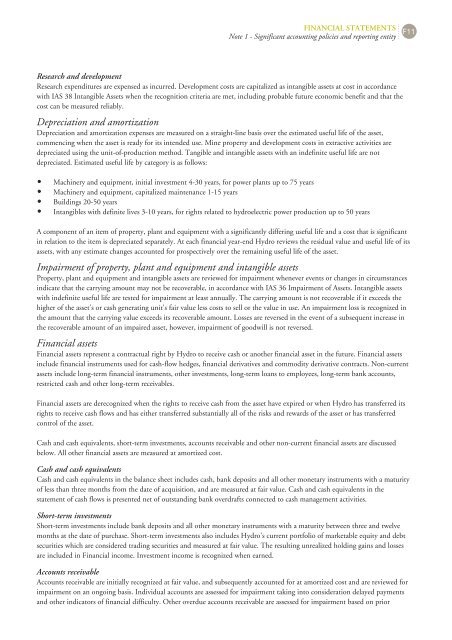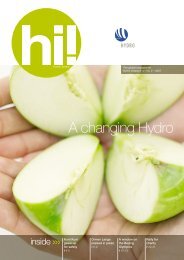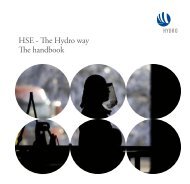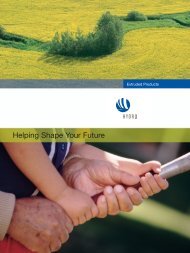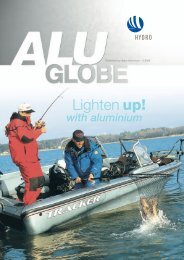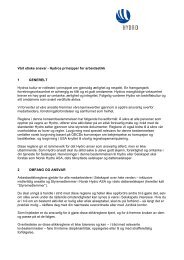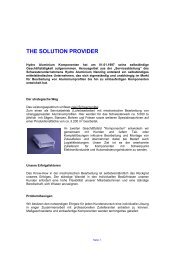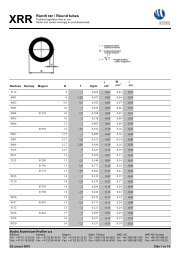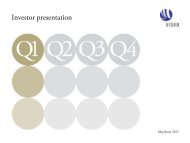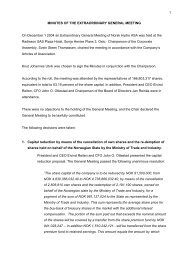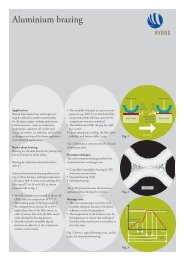Hydro Annual Report 2011b
Hydro Annual Report 2011b
Hydro Annual Report 2011b
Create successful ePaper yourself
Turn your PDF publications into a flip-book with our unique Google optimized e-Paper software.
FINANCIAL STATEMENTS<br />
Note 1 - Significant accounting policies and reporting entity F11<br />
Research and development<br />
Research expenditures are expensed as incurred. Development costs are capitalized as intangible assets at cost in accordance<br />
with IAS 38 Intangible Assets when the recognition criteria are met, including probable future economic benefit and that the<br />
cost can be measured reliably.<br />
Depreciation and amortization<br />
Depreciation and amortization expenses are measured on a straight-line basis over the estimated useful life of the asset,<br />
commencing when the asset is ready for its intended use. Mine property and development costs in extractive activities are<br />
depreciated using the unit-of-production method. Tangible and intangible assets with an indefinite useful life are not<br />
depreciated. Estimated useful life by category is as follows:<br />
Machinery and equipment, initial investment 4-30 years, for power plants up to 75 years<br />
Machinery and equipment, capitalized maintenance 1-15 years<br />
Buildings 20-50 years<br />
Intangibles with definite lives 3-10 years, for rights related to hydroelectric power production up to 50 years<br />
A component of an item of property, plant and equipment with a significantly differing useful life and a cost that is significant<br />
in relation to the item is depreciated separately. At each financial year-end <strong>Hydro</strong> reviews the residual value and useful life of its<br />
assets, with any estimate changes accounted for prospectively over the remaining useful life of the asset.<br />
Impairment of property, plant and equipment and intangible assets<br />
Property, plant and equipment and intangible assets are reviewed for impairment whenever events or changes in circumstances<br />
indicate that the carrying amount may not be recoverable, in accordance with IAS 36 Impairment of Assets. Intangible assets<br />
with indefinite useful life are tested for impairment at least annually. The carrying amount is not recoverable if it exceeds the<br />
higher of the asset's or cash generating unit's fair value less costs to sell or the value in use. An impairment loss is recognized in<br />
the amount that the carrying value exceeds its recoverable amount. Losses are reversed in the event of a subsequent increase in<br />
the recoverable amount of an impaired asset, however, impairment of goodwill is not reversed.<br />
Financial assets<br />
Financial assets represent a contractual right by <strong>Hydro</strong> to receive cash or another financial asset in the future. Financial assets<br />
include financial instruments used for cash-flow hedges, financial derivatives and commodity derivative contracts. Non-current<br />
assets include long-term financial instruments, other investments, long-term loans to employees, long-term bank accounts,<br />
restricted cash and other long-term receivables.<br />
Financial assets are derecognized when the rights to receive cash from the asset have expired or when <strong>Hydro</strong> has transferred its<br />
rights to receive cash flows and has either transferred substantially all of the risks and rewards of the asset or has transferred<br />
control of the asset.<br />
Cash and cash equivalents, short-term investments, accounts receivable and other non-current financial assets are discussed<br />
below. All other financial assets are measured at amortized cost.<br />
Cash and cash equivalents<br />
Cash and cash equivalents in the balance sheet includes cash, bank deposits and all other monetary instruments with a maturity<br />
of less than three months from the date of acquisition, and are measured at fair value. Cash and cash equivalents in the<br />
statement of cash flows is presented net of outstanding bank overdrafts connected to cash management activities.<br />
Short-term investments<br />
Short-term investments include bank deposits and all other monetary instruments with a maturity between three and twelve<br />
months at the date of purchase. Short-term investments also includes <strong>Hydro</strong>'s current portfolio of marketable equity and debt<br />
securities which are considered trading securities and measured at fair value. The resulting unrealized holding gains and losses<br />
are included in Financial income. Investment income is recognized when earned.<br />
Accounts receivable<br />
Accounts receivable are initially recognized at fair value, and subsequently accounted for at amortized cost and are reviewed for<br />
impairment on an ongoing basis. Individual accounts are assessed for impairment taking into consideration delayed payments<br />
and other indicators of financial difficulty. Other overdue accounts receivable are assessed for impairment based on prior


